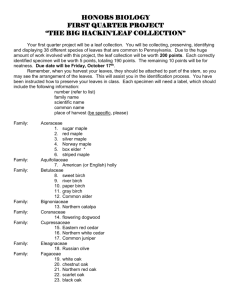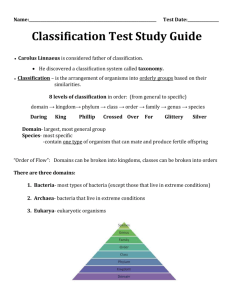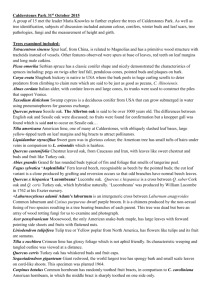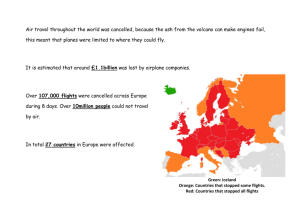Preferred Tree Species for Northeast Kansas
advertisement
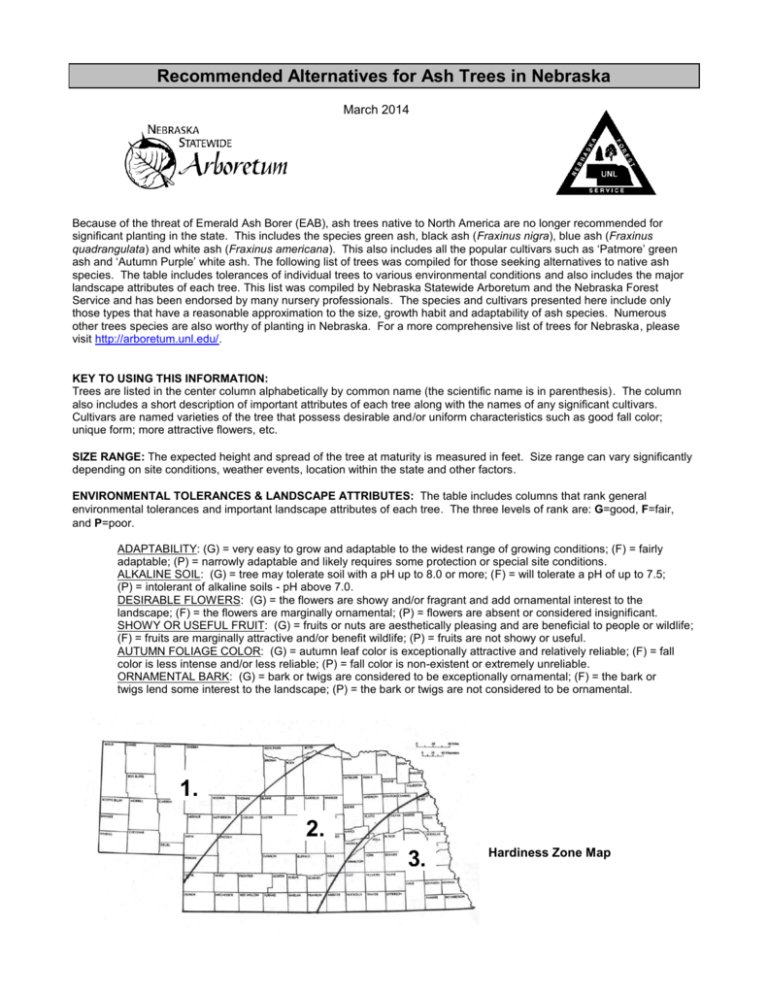
Recommended Alternatives for Ash Trees in Nebraska March 2014 Because of the threat of Emerald Ash Borer (EAB), ash trees native to North America are no longer recommended for significant planting in the state. This includes the species green ash, black ash (Fraxinus nigra), blue ash (Fraxinus quadrangulata) and white ash (Fraxinus americana). This also includes all the popular cultivars such as ‘Patmore’ green ash and ‘Autumn Purple’ white ash. The following list of trees was compiled for those seeking alternatives to native ash species. The table includes tolerances of individual trees to various environmental conditions and also includes the major landscape attributes of each tree. This list was compiled by Nebraska Statewide Arboretum and the Nebraska Forest Service and has been endorsed by many nursery professionals. The species and cultivars presented here include only those types that have a reasonable approximation to the size, growth habit and adaptability of ash species. Numerous other trees species are also worthy of planting in Nebraska. For a more comprehensive list of trees for Nebraska, please visit http://arboretum.unl.edu/. KEY TO USING THIS INFORMATION: Trees are listed in the center column alphabetically by common name (the scientific name is in parenthesis). The column also includes a short description of important attributes of each tree along with the names of any significant cultivars. Cultivars are named varieties of the tree that possess desirable and/or uniform characteristics such as good fall color; unique form; more attractive flowers, etc. SIZE RANGE: The expected height and spread of the tree at maturity is measured in feet. Size range can vary significantly depending on site conditions, weather events, location within the state and other factors. ENVIRONMENTAL TOLERANCES & LANDSCAPE ATTRIBUTES: The table includes columns that rank general environmental tolerances and important landscape attributes of each tree. The three levels of rank are: G=good, F=fair, and P=poor. ADAPTABILITY: (G) = very easy to grow and adaptable to the widest range of growing conditions; (F) = fairly adaptable; (P) = narrowly adaptable and likely requires some protection or special site conditions. ALKALINE SOIL: (G) = tree may tolerate soil with a pH up to 8.0 or more; (F) = will tolerate a pH of up to 7.5; (P) = intolerant of alkaline soils - pH above 7.0. DESIRABLE FLOWERS: (G) = the flowers are showy and/or fragrant and add ornamental interest to the landscape; (F) = the flowers are marginally ornamental; (P) = flowers are absent or considered insignificant. SHOWY OR USEFUL FRUIT: (G) = fruits or nuts are aesthetically pleasing and are beneficial to people or wildlife; (F) = fruits are marginally attractive and/or benefit wildlife; (P) = fruits are not showy or useful. AUTUMN FOLIAGE COLOR: (G) = autumn leaf color is exceptionally attractive and relatively reliable; (F) = fall color is less intense and/or less reliable; (P) = fall color is non-existent or extremely unreliable. ORNAMENTAL BARK: (G) = bark or twigs are considered to be exceptionally ornamental; (F) = the bark or twigs lend some interest to the landscape; (P) = the bark or twigs are not considered to be ornamental. 1. 2. 3. Hardiness Zone Map F G F G G P ALL G G F G G F F ALL ALL G F G G G ALL G F G G F ALL G F G G F 2,3 G F G G G ALL G F G G P 2,3 F F G 2,3 G F G G F ALL F F F F P 3 F F F F P 3 G P G G F ALL F P F G F G P ALL G F G G F ALL G F G F F ALL F F P F G ALL G F G F P 2,3 Linden, American (Tilia americana) Pyramidal shape; pendulous branches makes it difficult to use as a street tree; 'Redmond' is a common cultivar. Linden, Littleleaf (Tilia cordata) Densely pyramidal; pendulous branches makes it difficult to use as a street tree; 'Greenspire' is a common cultivar. Maple, Freeman (Acer x freemanii) Hybrid between red maple and silver maple. Good fall color; fast growth; weak wooded. Good for wet/moist soils. Many cultivars including ‘Armstrong’; ‘Autumn Blaze’ and ‘Marmo’. Maple, Miyabe (Acer miyabei) Distinctive glossy leaves; often low-branched and multi-stem. ORNAMENTAL BARK G F AUTUMN FOLIAGE COLOR G G P ALL SHOWY OR USEFUL FRUIT G F Ash, Manchurian (Fraxinus mandshurica) Manchurian ash is native to China and is considered to be relatively resistant to EAB. ‘Mancana’ is a variety with upright growth habit. Buckeye, Ohio (Aesculus glabra) Tough, easy to grow tree; rounded shape; native to region. Catalpa, Northern (Catalpa speciosa) Large tropical leaves; attractive flowers in spring; easy to grow. Corktree, Amur (Phellodendron amurense) Low, horizontal branching; distinctive corky bark; ash-like leaves. Coffeetree, Kentucky (Gymnocladus dioicus) Seedless cultivars available. Elm, American (Ulmus americana) Arching habit makes it a great street tree. Choose from disease resistant cultivars such as ‘Valley Forge’ & ‘New Harmony’. Elm, Japanese (Ulmus davidiana var. japonica) Rounded habit; tough and adaptable. Elm, Lacebark (Ulmus parvifolia) Nice shape and beautiful mottled bark; may not be cold hardy in northern/western Nebraska; choose from a hardy seed source or cultivars such as ‘Emerald Prairie’. ‘Frontier’ is a hybrid type with vigorous growth and purple/red fall color. Elm, misc. hybrids (Ulmus x spp.) Many disease-resistant hybrid elms are available including proven cultivars such as ‘Accolade’, ‘Discovery’, ‘New Horizon’, ‘Pioneer’, ‘Triumph’, and ‘Vanguard’. Easy to grow; good as street trees. Goldenraintree (Koelreuteria paniculata) Large compound leaves; attractive yellow flowers in late spring; distinctive heart-shaped seed pods. Ginkgo (Ginkgo biloba) Cultivars: 'Autumn Gold'; 'Princeton Sentry'; ‘Magyar’. Male cultivars recommended for most community plantings. Hackberry (Celtis occidentalis) Easy to grow native; good for birds; somewhat over planted. Hickory, Bitternut (Carya cordiformis) Compound leaves similar to ash; prefers rich, moist soil. Hickory, Shagbark (Carya ovata) Large compound leaves; prefers rich, moist soil. Honeylocust, Thornless (Gleditsia triacanthos var. inermis) Cultivars: 'Shademaster', 'Skyline', ‘Imperial’. Ironwood (Hophornbeam) (Ostrya virginiana) Native forest understory tree; tough wood; slow growth rate. DESIRABLE FLOWERS ALL (typically over 40 feet tall at maturity) 40-60 30-40 P P G F 25-40 25-40 G G F F 40-60 30-40 G F P F 30-40 40-50 F F F F 50-60+ 30-45 P F F F 60-80 50-70 P P F F 30-40 30-40 P P F F 30-40 25-35 P F F G 40-60+ 40-60+ P P F F 30-40 30-40 G G F F 50-60+ 25-40 P F G F 50-70 40-60 P G F G 50-60 30-40 G G F F 50-60 30-40 G G F G 40-60+ 30-50 P F F F 25-40 20-30 F G G F 50-60+ 35-40 G F F F 50-60 25-40 G F F F 50-60 40-50 P P G F 25-40 20-35 F F G F MATURE SPREAD HARDINESS ZONE F LARGE DECIDUOUS TREES LANDSCAPE ATTRIBUTES MATURE HEIGHT WET SOIL TOLLERANCE G G SHADE TOLLERANCE G F ADAPTABILITY DROUGHT TOLLERANCE ALKALINE SOIL (HIGH pH) ENVIRONMENT (tolerant of) F G F G F 2,3 Maple, Norway (Acer platanoides) Dense shade. Cultivars include ‘Emerald Queen’, ‘Superform’, ‘Emerald Lustre’ and ‘Crimson King’ (red leaf variety). 40-50 40-50 F F F F F G F P G 2,3 Maple, Red (Acer rubrum) Good fall color; good for wet/moist soils. Cultivars include ‘Red Sunset’, ‘October Glory’; 'Autumn Flame', ‘Burgundy Belle’. 30-50 30-50 F F G F G G F F F 2,3 Maple, Sugar (Acer saccharum) Beautiful tree with good fall color; more drought tolerant than other maples; cultivars include 'Legacy', Caddo, ’Fall Fiesta’, ‘Bonfire’. 40-60+ 30-50 P F G G G F G G F ALL 50-60 50-70 F F P F G F F F 2,3 50-60 40-50 F F G F G F G G P ALL 40-50+ 30-40 F F F F G F F G F ALL 40-60+ 45-65 F F P F G F F G F ALL 50-60 40-50 F F G F G F F F F 2,3 40-60+ 30-40 F F F F G F F G F 2,3 40-50 30-40 F F F F G F F G F 2,3 60-80 40-60 F F G F G F P G G 2,3 50-60 40-60 F F G F G F F G F 2,3 50-70 40-60 F F G F G F G G F 2,3 30-40+ 20-40 P G G F F F G F F 2,3 25-40 20-35 G F F F F F G F G 2,3 60-80 50-60 P F P G F F F G G 2,3 60-80 50-60 P F P G F F P P G 3 Oak, Bur (Quercus macrocarpa) One of the best trees for Nebraska; easy to grow and long-lived. Oak, Chestnut (Quercus prinus) Distinctive chestnut-like leaves; attractive blocky bark. Oak, Chinkapin (Quercus muehlenbergii) Underutilized native tree; distinctive serrated leaves; thinner canopy than most oaks; good on high pH soils. Oak, English (Quercus robur) Attractive tree - nice rounded shape and glossy leaves; long acorns; needs protection in western Nebraska. Oak, Red (Quercus rubra) Easy to grow; reliable fall color; needs protection in western Nebraska; avoid high pH soils. Oak, Sawtooth (Quercus acutissima) Distinctive sawtooth-edged leaves; fast growth rate; nice shape. Oak, Shingle (Quercus imbricaria) Distinctive narrow leaves; holds leaves into winter. Oak, Shumard (Quercus shumardii) Very similar to red oak; good fall color; drought tolerant. Oak, Swamp White (Quercus bicolor) Popular tree; flaky bark on young trunk/branches; good on wet sites; easy to grow; avoid high pH soils. Oak, White Oak (Quercus alba) Similar in stature to bur oak; great fall color; few acorns. Osage Orange (Maclura pomifera) Glossy leaves; large, orange-like fruits; easy to grow. Pagodatree, Japanese (Sophora japonica) Large compound leaves; attractive flowers in late summer; distinctive green bark on young stems Planetree, London (Platanus x acerifolia) A hybrid sycamore but not as messy as the native sycamore; attractive smooth, white to mottled bark; good on wet sites. Sycamore (Platanus occidentalis) Native planetree; attractive mottled/white bark; can be messy; one of the largest growing trees. Sweetgum (Liquidambar styraciflua) Needs protected site; distinctive pointy fruit balls; select from northern proven seed sources. Walnut (Juglans nigra) Tough, easy to grow native; fruits can be messy; leaf diseases common. Yellowwood, American (Cladrastis kentukea) Attractive panicles of creamy flowers in spring; smooth bark. 40-55 30-40 F F G F 40-60 40-60 F F P F 25-40 25-40 G F F F G F F F G G G F ALL F P 3 F For further information or to provide comments to this listing please contact: Justin Evertson, Nebraska Statewide Arboretum - (402) 472-5045 - jevertson1@unl.edu Additional tree selection and care information can be found on-line at: http://arboretum.unl.edu or http://www.nfs.unl.edu/. Revised March, 2014

